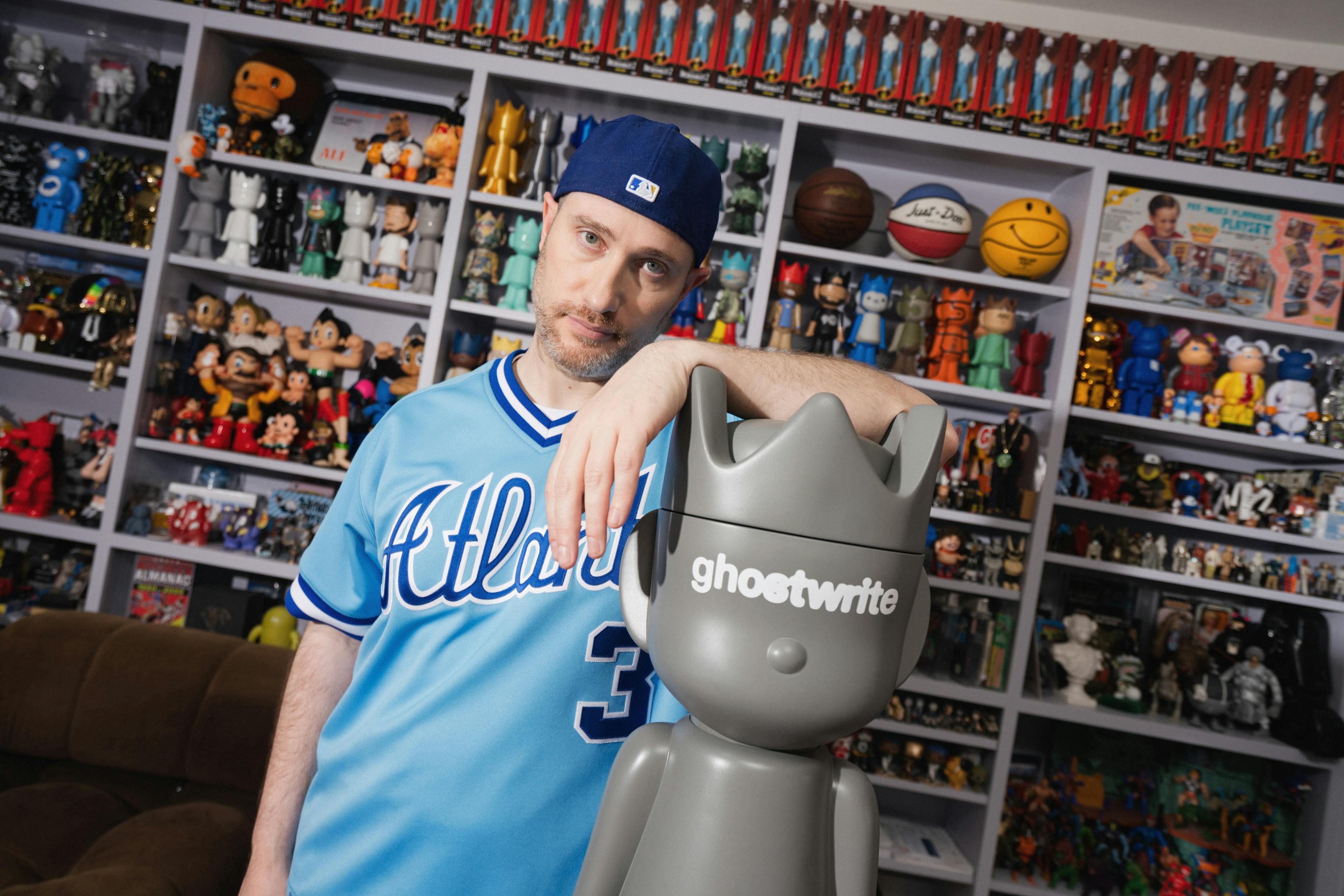Cofounder of StockX is building value out of vapor with his new collectible startup, Ghostwrite
Josh Luber gets transparent with Sherwood about how to create hype, stoke demand, and regulate supply.
Ghostwrite founder Josh Luber has spent his career figuring out what turns sneakers into keepsakes and toys into treasures.
Now Luber, who cofounded the resale site StockX as well as the collectibles division of sports-card and apparel giant Fanatics, is trying to send his latest startup into the stratosphere by giving a master class on how to create demand and control supply.
Step one: create incredible hype around collectible toy ghosts.
Ghostwrite spent a year stoking demand before selling any of its “ghosts” — humanoid figures with crown-shaped heads that can resemble anything from a pro golfer to a pencil. Over the course of that year, Ghostwrite created ghosts in limited quantities and instead of selling them, it gave the toys away to influential industry figures.
“The No. 1 thing to start driving demand is to show the world the product. Great product is first and foremost before anything else,” Luber told Sherwood.
Last December, Ghostwrite gifted a custom Tiffany & Co.-themed ghost to Alexandre Arnault, the jeweler’s VP of product and comms and also the son of LVMH CEO and megabillionaire Bernard Arnault. Later, when streetwear brand Clot left Nike to collaborate with Adidas, Ghostwrite designed 10 ghosts featuring both brands’ logos as its eyes. It then gave away the figures to people who attended the brands’ February kickoff party in LA.
To get the word out, Ghostwrite put its products into the hands of influential people. That approach created demand for its previously unknown collectibles while hooking brands’ interest for potential future collabs. And while the brands dominating markets like collectible sneakers and fashion are ultra-entrenched — like Nike and Dior — the toy biz has room for newbies.
Ghostwrite will begin promoting an upcoming ghost in partnership with the WNBA, which is skyrocketing in popularity, today, according to a company spokesperson.
“Collectible toys are able to work with all those same brands, all the most important people and culture. But the industry is not so big that you have all these monoliths already in place,” Luber said.
Part of Ghostwrite’s appeal to brands is its design. It’s the evolution of another toy line, Bearbricks, which Luber called the longest-running and most successful collectible toy franchise. Unlike other figurines made by the likes of Funko and Kaws, Ghostwrite and Bearbricks are what’s known as blank-canvas toys: their bodies are so amorphous, they can take on designs that aren’t just people or animals. One ghost is designed to evoke a basketball.
Luber thinks there’s room in the collectibles biz for more blank-canvas toys, and its year spent building hype convinced partners to agree. In addition to the WNBA partnership being promoted today, Ghostwrite has a collab coming up with the MLB.
“The idea is taking everything that we learned in sneakers and trading cards and applying it to the collectible-toy industry — which is big enough to matter but not so big that anyone really has been doing this yet,” he said.
Once Luber sparked demand from brands and future buyers, he started testing the other side of the value equation: how to create scarcity. To control the supply of ghosts, Ghostwrite decided to sell them via blind Dutch auctions.
In a blind Dutch auction, people bid how much they’re willing to pay — and unlike an eBay sale, they have no clue how much everyone else is bidding. If there are 20 ghosts up for sale, the 20 highest bidders win the auction. But they don’t pay the amounts they bid. Instead, they all pay the amount proposed by the lowest winning bidder.
Starting off slow, earlier this year Ghostwrite held several small-scale “family and friends” auctions. It sold 20 ghosts in May via a blind Dutch auction open to only 300 buyers. The final clearing price, or the amount all 20 winning bidders paid, was $417. In a signal that the public was ready to get in on the action, prices of the ghosts shot up on the resale market. Luber said three of the ghosts resold on StockX for $1,400, $1,800, and $2,500.
In August, Ghostwrite finally opened to the public. Its first ghost, a plain gray figure meant to play up the toy’s ability to be a blank canvas for collabs, ended up selling to 20 bidders for a clearing price of $1,026.
Now things are starting to ramp up. Last month Ghostwrite sold 50 figures made in collaboration with sports brand East Side Golf for $300 each. This month, it sold a ghost made in partnership with the NBA, and 60 sold for a clearing price of about $500 each.
Luber’s seeing his supply-demand experiment play out in real time, and it seems to be a success so far. As he does so, he thinks the collectibles biz in general, including trading cards and sneakers, has room to grow and evolve.
“All of these brands and all of these categories are continuing to learn from each other to figure out how to make the right products, do the right collaborations, and create the right scarcity,” he said. “It hasn’t always been this way. These brands have existed in silos for a while.”
Whether Ghostwrite becomes a valuable collectible with a storied legacy — or a trend that disappears like vapor — will depend on whether the little ghost figurines can combine what worked in its collectible competitors’ past lives with fresh strategies for the industry’s next phase.
